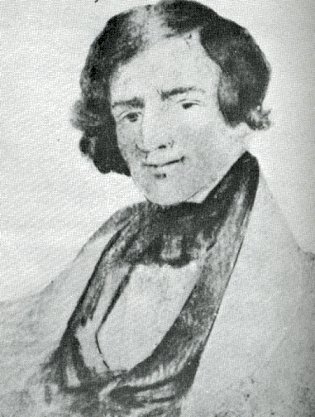Rocky Mountain Fur Company
Compiled by Stephenie Flora

The Rocky Mountain Fur Company was the fourth fur company to operate
within the Pacific Northwest and the last to appear on the scene. It
was an
American company, organized in St. Louis in 1823 by Major Andrew Henry
and General William H.
Ashley. Major Henry had gained fame for having built Fort Henry in what
is now southern Idaho. General Ashley is described as a "little man who
always had a stomach ache," but this did not prevent him from clearing
$50,000 to $60,000 a year during the first four years of the company's
life.
In 1826 Jedediah Smith, William and Milton Sublette
and David Jackson
bought the Rocky Mountain Fur Company and for the next seven years it
continued to prosper as the firm of Smith, Jackson & Sublette until it was sold and once again became the Rocky Mountain Fur Company.
Unlike the other three fur companies, the Rocky
Mountain Fur Company
did not build forts or trading houses. This meant that trappers had
no home base. They lived independently, fending for themselves. They
caught their own food, found their own shelter and fought off wild
animals and hostile indians. These men were called "mountain men". They
led exciting but lonely lives and became the subject of many a
dime novel. Some of these men included (in addition to Smith and the
Sublettes) Jim Bridger, Joe Meek, Robert Newell, and Kit Carson.
Every summer the mountain men, indian trappers and
traders for the Rocky Mountain Fur Company would gather at a
"rendezvous" to trade the pelts. It was a chance to relax and enjoy
themselves after a long season in the mountains. They gambled and drank
and
danced. It became a giant pow-wow, a carnival, and a circus all rolled
into one.
The Rocky Mountain Fur Company was constantly
challenging the domain
of the Hudson's Bay Company. Their rendezvous were consistently located
near a Hudson's Bay Company post in an attempt to draw off some of the
Indian trade. A number of the mountain men went into the Snake River
region of Oregon where they competed with the Company's Snake River
brigade for trade with the Indians. They also penetrated the Umpqua
and Rogue River Valley which was considered the domain of the Hudson's
Bay Company.
 In 1826 Jedediah Smith pioneered a trail from the
Bear Lake rendezvous
to a Spanish mission in southern California. After a trapping
expedition
into northern California, he made his way back to Bear Lake. In 1827
he led a party of 20 men over the northern California mountains into
the Oregon Country. This expedition proved to be a disaster. Not only
did they suffer terrible hardship in crossing the mountains but they
were attacked in the Umpqua River region and all but three of the party
were massacred. Smith was one of the lucky ones. He had been out
scouting when the attack took place.
In 1826 Jedediah Smith pioneered a trail from the
Bear Lake rendezvous
to a Spanish mission in southern California. After a trapping
expedition
into northern California, he made his way back to Bear Lake. In 1827
he led a party of 20 men over the northern California mountains into
the Oregon Country. This expedition proved to be a disaster. Not only
did they suffer terrible hardship in crossing the mountains but they
were attacked in the Umpqua River region and all but three of the party
were massacred. Smith was one of the lucky ones. He had been out
scouting when the attack took place.
After the attack, Smith traveled north to Fort
Vancouver with about
800 pelts that the party had collected. McLoughlin greeted him
warmly and accepted the furs in exchange for supplies. He also
instructed
the leader of his Umpqua brigade to locate the hostile indians and
punish them. It was McLoughlin's policy to treat the indians fairly but
to maintain firm control. It was not to the benefit of the
Hudson's Bay Company to have hostility in the region.
While at Fort Vancouver, Smith was able to obtain
first hand information
about the fort. He reported in letters to the east that the fort
looked like a permanent establishment, with its many inhabitants,
its gardens, livestock and shops. He complained to the American
government that the British were trying to keep Americans out of the
territory.

My name is Stephenie Flora. Return to [ Home Page ]
All [ Comments
and Inquiries ] are welcome.
 In 1826 Jedediah Smith pioneered a trail from the
Bear Lake rendezvous
to a Spanish mission in southern California. After a trapping
expedition
into northern California, he made his way back to Bear Lake. In 1827
he led a party of 20 men over the northern California mountains into
the Oregon Country. This expedition proved to be a disaster. Not only
did they suffer terrible hardship in crossing the mountains but they
were attacked in the Umpqua River region and all but three of the party
were massacred. Smith was one of the lucky ones. He had been out
scouting when the attack took place.
In 1826 Jedediah Smith pioneered a trail from the
Bear Lake rendezvous
to a Spanish mission in southern California. After a trapping
expedition
into northern California, he made his way back to Bear Lake. In 1827
he led a party of 20 men over the northern California mountains into
the Oregon Country. This expedition proved to be a disaster. Not only
did they suffer terrible hardship in crossing the mountains but they
were attacked in the Umpqua River region and all but three of the party
were massacred. Smith was one of the lucky ones. He had been out
scouting when the attack took place.